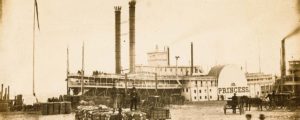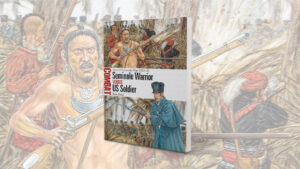This New York City borough reminds us that the war’s fury reached far beyond the front.
During the Civil War, Brooklyn was a city unto itself, one of the largest in the United States. Figures for the number of Brooklyn men who served in the war vary wildly—one source will tell you 32,000, another states as many as 150,000. Most historians throw up their hands and say merely “thousands.”
Leading the way were the Brooklyn soldiers who comprised “the fighting 14th” regiment of the New York State Militia. Outfitted by the city, these men went off to war in colorful uniforms—bright red pants, dark blue coats and caps, and white leggings. They became known as the “Red-legged Devils” because of their red pants and stubborn bravery.
And when it comes to monuments commemorating the Civil War, few cities can outdo Brooklyn.
Among them is an arch, a splendid colossus that is arguably the finest example of triumphal architecture in the country, and perhaps second only to the Arc de Triomphe in Paris. The Soldiers’ and Sailors’ Memorial Arch, dedicated to “the defenders of the Union, 1861-65,” stands in Grand Army Plaza, a landmark named for the Grand Army of the Republic. Designed by John H. Duncan and completed in 1892, it is Brooklyn’s best-known icon of the Civil War.
On the inner sides of the arch, Abraham Lincoln and Ulysses Grant in bas relief, by Thomas Eakins and William O’Donovan, respectively, gaze down at us. They are quiet, meditative figures. In contrast, on each huge south pedestal, a tight group of swashbuckling men representing the Army and the Navy is caught in combat by sculptor Frederick MacMonnies. Common soldiers are revered here, as opposed to the wealth of Civil War monuments that honor generals and other officers. Even more unusual for the time, the Navy group includes a black sailor, kneeling and holding a gun.
And atop this 80-foot behemoth is a spectacular MacMonnies work: A victorious Columbia, banner flying aloft, stands in a chariot, with two exuberant winged female figures beside the four prancing horses.
As the city enlarged around the plaza, the Soldiers’ and Sailors’ Memorial Arch became stranded on a little apron of grass in the middle of a busy traffic circle. Reaching it on foot is a daring and risky adventure and there is no place to stand back for a view of the impressive trio and the chariot and horses on the top. But at night the arch is bathed in light, so passersby can cast an admiring glance across the many avenues that radiate from the traffic circle.
The first of Brooklyn’s many monuments to be erected was a standing, statesmanlike statue of Lincoln, originally dedicated in 1869. Added since then are a Civil War cannon, statues of Grant and Maj. Gen. Henry W. Slocum, a memorial to the USS Monitor and Merrimac and two Gettysburg memorial tablets. And perhaps second only to the arch at Grand Army Plaza is the handsome Soldiers’ Monument in Green-Wood Cemetery, completed in 1876.
Founded in 1838, Green-Wood embodied the then new idea that a cemetery should be a peaceful and picturesque reflection of God and nature, unconnected to any particular church. Trees, shrubs, ponds and flowerbeds—interspersed among the mausoleums, monuments and headstones— give the cemetery a bucolic atmosphere. Parts of its rolling 478 acres offer splendid views of New York Harbor. In all, Green Wood is a fine place to end up, and so far, at least 560,00 people—celebrities, regular folks and Civil War veterans—are buried there.
During the war, Green-Wood established a Soldiers’ Lot expressly for the free burial of New York soldiers who died in battle or from sickness incurred while on duty. Records show many Civil War veterans, Union and Confederate, officers and enlisted men, buried at Green-Wood, their graves scattered over the grounds. Some graves are adorned with statues and carvings, others only with markers that were obliterated over time. Who were those forgotten men?
In 2002 Green-Wood historian Jeffrey I. Richman helped launch a project to identify and gather information on every Civil War veteran interred there. Researchers, many of them volunteers, pored through old documents, obituaries, pension records and other sources. So far, 3,300 Civil War veterans have been identified at Green Wood. Requests have been filed with the Veterans Administration for gravestones, to be placed upright on each known grave. Richman has compiled a handsome book, Final Camping Ground: Civil War Veterans at Brooklyn’s Green-Wood Cemetery, In Their Own Words, with letters and biographical material about each veteran.
The stories are often poignant. “Dear mother, do not cry for me, for I am well off, and I hope to return to you in three months or sooner,” wrote Clarence D. McKenzie on May 28, 1861, from Annapolis, Md. “Please send me another cake, for the boys took it all from me.”
One of the young drummer boys who beat cadence at parades and marches, McKenzie was killed the following month in an accident at the camp. He was 12 years old. McKenzie was Brooklyn’s first fatality of the war, and a statue, Our Drummer Boy, memorializes him at Green-Wood.
While statues that honor officers from both sides abound at the cemetery, there is a fine Soldiers’ Monument dedicated to the regular soldier. On a grassy rise next to a winding road, it stands out even from the showy mausoleums and statues in the background. Four soldiers representing different branches of the Army—infantry, cavalry, artillery, engineers—pose at the base of a granite obelisk.
In addition to filling Brooklyn’s largest cemetery, the war—and the events that led up to it—left an indelible mark elsewhere in the borough. The Union ironclad Monitor was fitted and commissioned at the Brooklyn Navy Yard, which remained busy building and repairing ships throughout the war. The politics of slavery shaped political attitudes in the borough and helped change the character of its population. While the state abolished slavery in 1827 and there were free blacks among the population, many New York residents still supported slavery. But abolitionist sentiment was strong among hundreds, perhaps thousands, of Brooklynites. Fugitive slaves found refuge in Brooklyn, and blacks fleeing the deadly 1863 draft riots in Manhattan crossed the East River to relative safety there.
Some who sought refuge in Brooklyn were sheltered by residents of Weeksville, a community of free blacks founded in 1838 by longshoreman James Weeks along an old Indian trail known as Hunterfly Road, then at the outskirts of Brooklyn. Between 30 and 40 relatively prosperous families joined him there, building neat, modest frame houses. In the 1850s the community likely offered comparative security to African Americans, whose safety was jeopardized by the Fugitive Slave Act. The law requiring the return of escaped slaves to their Southern owners promoted a booming business in the kidnapping and sale of blacks to slave traders. In many parts of New York, no African American, even a free black, was safe on the streets.
The position of African Americans in New York became even more uncertain after the draft riots in Manhattan. Enraged because wealthy New Yorkers could buy their way out of conscription into the Union Army, impoverished and exploited white industrial workers turned their fury on blacks as the war increasingly became a struggle against slavery instead of merely a war against secession. Mobs attacked and sometimes lynched people of color. Rioters burned homes and even a “colored” orphans asylum. Many African Americans fled the city in fear, but if they reached Weeksville, they were safe.
A number of Weeksville men joined the all-black regiment, the Massachusetts 54th Infantry, formed in 1863. Under command of white officers, the 54th suffered the same terrible losses as did most other regiments but proved as brave as any of them.
At its height, Weeksville covered some seven blocks with roughly 500 families; but over the years it was absorbed by surrounding neighborhoods. Buildings disappeared or fell into disrepair. It wasn’t until the 1960s and 1970s that historians and community activists began to identify and preserve what remained of the community. Four original houses on the grassy path that was Hunterfly Road were restored and declared landmarks, and Weeksville is listed on the National Register of Historic Places. Today, a new Heritage Center is being built opposite the old houses.
While the city of New York was considered pro-slavery, parts of Brooklyn were hotbeds of abolitionist sentiment—and none more so than Plymouth Church, established in 1847 as a Congregational church, in Brooklyn Heights on the East River opposite Manhattan. Plymouth’s fiery, charismatic minister, Henry Ward Beecher, defiantly broadcast his opinions.
There is fairly solid evidence that runaway slaves were routinely hidden in the church’s catacomb-like basement. “I regularly drop off fugitives at Henry Ward Beecher’s Plymouth Church in Brooklyn,” wrote an African-American newspaper editor of the time. According to Lois Rosebrooks, the church’s director of History Ministry Services, personal memoirs and oral histories indicate members took escapees into their homes, fed them and helped them to the next stop on the Underground Railroad. Plymouth was apparently known secretly as Grand Central Depot.
During one Sunday service, Beecher staged an “auction” of a young mulatto girl. The auction was hugely successful, the girl’s freedom bought, and Beecher realized he had a hot idea. Ever the showman, he began holding such auctions often, whipping up his congregation into an anti-slavery frenzy. “Over time, some 13 African Americans were freed this way,” says Rosebrooks.
One such fortunate slave was a little girl named Pinky. During her auction, a church member dropped a gold ring into the collection plate. Beecher dramatically placed the ring on the child’s finger, saying, “There, you are wed to your freedom.” This moment is commemorated in an Eastman Johnson painting that hangs in the church arcade. When the church marked its 80th anniversary, Pinky’s “wedding” was commemorated in a poignant observance. Beecher had long been dead (he passed away in 1887 and is buried at Green-Wood), but Pinky, by then quite elderly, was still alive. In a moving ceremony, she returned the ring. Beecher also donated rifles—dubbed
“Beecher’s Bibles” by the press—for antislavery Free Soilers who settled in Kansas during the slavery conflict there.
During Beecher’s ministry, Plymouth Church became so popular that ferries bearing visitors from the rest of New York City to his services came to be called “Beecher Boats.” When Lincoln asked Beecher to speak at Fort Sumter at the war’s end, so many of his followers wanted to make the journey to hear him that a steamer had to be chartered for the voyage.
Brooklyn has always claimed another famous personality associated with the war—Walt Whitman—as its own. He lived in the borough and edited the Brooklyn Eagle. The poet spent much of the Civil War working as a volunteer nurse in Army hospitals. On May 28, 1869, he wrote in his journal a touching report of two brothers, William and Clifton Prentiss—one Union, one Confederate—who were both badly wounded in a battle near Petersburg, Va., and wound up in the same Washington, D.C., hospital. Whitman nursed them tenderly. The Confederate brother, William, died there. Clifton returned to his home in Brooklyn but died two months later.
The brothers’ graves are side-by-side at Green-Wood.
Longtime magazine writer and editor Patricia Curtis moved to Brooklyn 12 years ago and has never looked back. Brian Rose’s photos are in collections at the Metropolitan Museum of Art and the Museum of Modern Art.
Originally published in the May 2010 issue of America’s Civil War. To subscribe, click here.




